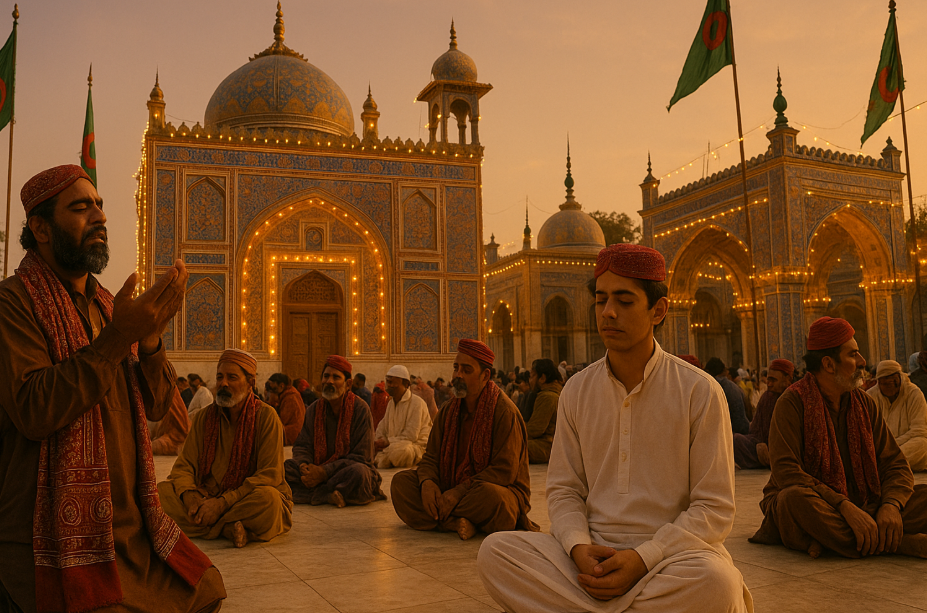Urs of Shah Abdul Latif Bhitai
The Urs of Shah Abdul Latif Bhitai is an annual spiritual and cultural event held in Bhit Shah, a small town in the Sindh province of Pakistan. It commemorates the death anniversary (Urs) of the revered Sufi saint, poet, and mystic Shah Abdul Latif Bhitai (1689–1752), whose poetry and philosophy remain a cornerstone of Sindhi identity, literature, and Sufi tradition.
When is Shah Abdul Latif Bhitai Holiday?
It is observed annually in the Sindh province of Pakistan to honor the death anniversary of the great Sufi poet and saint, Shah Abdul Latif Bhitai. It usually falls on the 14th of Safar, the second month of the Islamic lunar calendar, and is marked by a public holiday in Sindh.
Who Was Shah Abdul Latif Bhitai?
Shah Abdul Latif Bhitai was a prominent Sufi poet and a philosopher of love, mysticism, and universal humanism. Writing primarily in Sindhi, his poetry reflects themes of divine love, unity, tolerance, and devotion to God. His most famous work, “Shah Jo Risalo”, is a compilation of poetic verses that draw on Sindhi folklore and Sufi metaphors, portraying the journey of the soul towards union with the Divine.
He is widely regarded as the national poet of Sindh and a bridge between the spiritual and cultural fabric of the region.
The Urs: A Spiritual Pilgrimage
The Urs (literally meaning “wedding,” symbolizing the union of the soul with the Divine) is observed annually on 14th Safar, the second month of the Islamic lunar calendar. The festival spans three days, attracting thousands of devotees, Sufi followers, musicians, scholars, and tourists from across Pakistan and beyond.
Location: Bhit Shah
The Urs takes place at Shah Abdul Latif’s shrine in Bhit Shah, a town about 200 kilometers northeast of Karachi. The shrine, built in the 18th century, is a beautiful example of Sindhi Islamic architecture, decorated with glazed tiles, intricate patterns, and calligraphy of Shah Latif’s verses.
Rituals and Events During the Urs
1. Quran Recitations and Fatiha
The Urs begins with the recitation of the Holy Quran and prayers (Fatiha) at the shrine. Religious scholars offer tributes to Shah Latif’s spiritual legacy.
2. Sufi Music and Poetry (Shah Jo Raag)
Music is central to the celebrations. Every night during the Urs, Shah Jo Raag—a musical rendition of Shah Latif’s poetry—is performed by traditional musicians called Faqeers. These performances are held in the “Hujra” (a chamber within the shrine complex) and continue all night, in a deeply immersive spiritual atmosphere.
3. Mehfil-e-Samaa (Sufi gatherings)
Sufi gatherings and Dhamaal (a spiritual dance) are common, as devotees lose themselves in divine ecstasy through music and prayer. This expresses the Sufi belief in experiencing closeness to God through art and devotion.
4. Literary Conferences and Cultural Exhibitions
The Urs also includes literary seminars and discussions on Shah Latif’s philosophy, his contributions to poetry, and the relevance of his teachings in modern times. Exhibitions featuring Sindhi handicrafts, books, calligraphy, and art are also organized, reflecting the region’s cultural richness.
5. Devotional Offerings and Langar
Pilgrims offer flowers, chadars (cloths), and incense at the saint’s grave. Free meals (Langar) are served to all attendees, reflecting the Sufi values of sharing and community.
Cultural Significance
Urs is not just a religious festival but a cultural affirmation of Sindhi identity. It unites people from diverse backgrounds in a celebration of peace, tolerance, and universal love. His poetry continues to inspire movements for social justice, human rights, and spiritual awakening.
Through his timeless verses, Shah Latif emphasized:
- Love as the path to God
- Empathy for the marginalized
- Harmony among different faiths and cultures
The Urs of Shah Abdul Latif Bhitai stands as a testament to the enduring power of Sufi tradition in South Asia. It is a vibrant fusion of devotion, music, literature, and communal harmony, echoing the message of love and unity preached by the great saint. For Sindhis and admirers of Sufism around the world, the Urs is both a pilgrimage of the heart and a celebration of a poetic soul who sought the Divine in the rhythms of everyday life.

